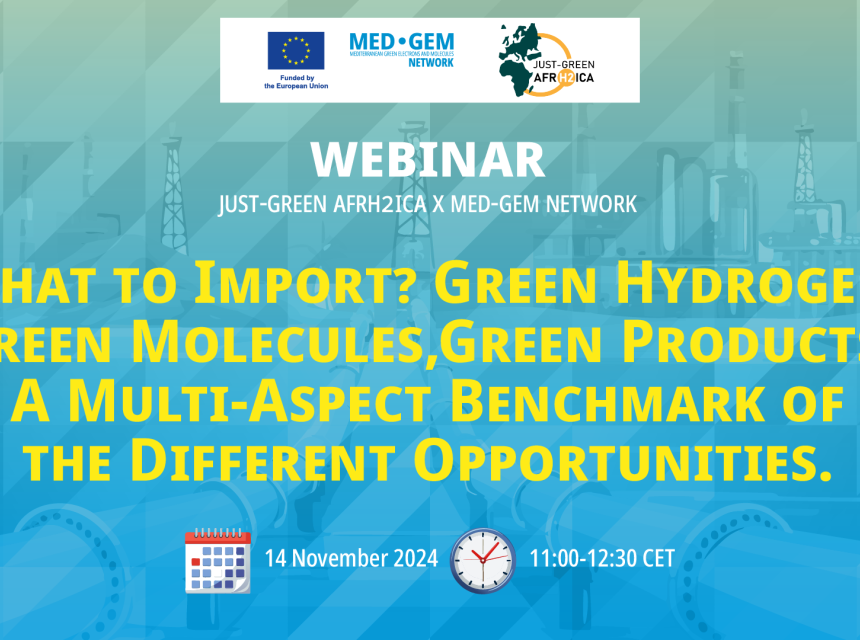What to Import? Green Hydrogen, Green Molecules, Green Products? A Multi-Aspects Benchmark of the Different Opportunities.
What to Import? Green Hydrogen, Green Molecules, Green Products? A Multi-Aspects Benchmark of the Different Opportunities
The global shift towards a greener economy is driving vital discussions on cross-regional collaboration, particularly Africa’s potential to supply Europe with sustainable energy. Should Europe prioritize importing green hydrogen, hydrogen carriers, or fully synthesized green products?
On November 14th, the Just-Green AFRH2ICA and MED-GEM Network hosted their second joint webinar to address this critical question. Featuring insights from Stefano Barberis (Università degli Studi di Genova) and Antonio Tuzio (STAM S.r.l.), the session examined the economic, technical, and industrial dimensions of Africa-Europe hydrogen trade and outlined the steps needed to build a strong manufacturing value chain in Africa.
Hydrogen or Value-Added Products: A Strategic Decision, by Stefano Barberis
Stefano Barberis addressed the question of whether Europe should focus on importing green hydrogen in its pure form or as part of value-added products like ammonia, methanol, or green steel. While Africa’s renewable energy potential enables green hydrogen production at costs as low as €2.5/kg in select regions, Barberis noted the logistical and economic challenges of transporting pure hydrogen, including its low density and liquefaction costs.
Key takeaways:
- Hydrogen Carriers: Ammonia and methanol are easier and cheaper to transport, leveraging existing logistics.
- Synthesized Products: Producing goods like steel and concrete locally in Africa not only minimizes transport costs but also supports local economies.
“By creating value locally, Africa can capitalize on its resources while reducing transport inefficiencies for Europe“
Barberis explained. He also emphasized that policies such as carbon credits or trade incentives could encourage European industries to invest in local production facilities in Africa, making synthesized products a more sustainable and economically viable option.
Building Africa’s Green Hydrogen Value Chain, by Antonio Tuzio
Antonio Tuzio outlined a roadmap for establishing Africa as a manufacturing hub for electrolyzers and other green hydrogen technologies. While Africa is rich in raw materials like steel, aluminum, and copper, Tuzio highlighted the need for local processing capabilities and industrial expertise to complete the value chain.
Mr Tuzio identified sectors with potential for knowledge transfer to hydrogen manufacturing:
- Chlorine-Alkali Industry: Electrolyzers already play a role in chlorine production, providing a natural starting point.
- Fertilizer Manufacturing: The hydrogen-intensive ammonia production process can transition to green hydrogen.
- Oil Refineries: Extensive hydrogen use in refining offers transferrable expertise.
To address workforce gaps, Tuzio emphasized the importance of capacity building, education programs, and collaborations between African industries and global stakeholders.
“Africa has the resources, but expertise and knowledge must be cultivated across all levels, from plant operators to engineers“
he remarked.
The interactive Q&A session brought forward several key considerations:
Country Selection and Hydrogen Costs
Programme Manager for Regional Programmes Neighbourhood South - Energy, from the Directorate-General for Neighbourhood and Enlargement Negotiations of the European Commission, Milou Beerepoot, questioned the focus on Morocco, Kenya, and South Africa, excluding Egypt. Mr Barberis explained that these countries were chosen due to access to precise data and local renewable energy profiles. He also confirmed that hydrogen production in Africa is cost-competitive compared to Europe, but transporting pure hydrogen to Europe inflates costs to €6.7/kg or more.
“Producing value-added products in Africa is often more cost-effective than transporting hydrogen for production in Europe“
he emphasized.
Job Creation and Skills Development
Communication & dissemination MED-GEM Network’s Key Expert Raya Verniers inquired about capacity-building priorities for hydrogen-related jobs. Mr Tuzio stressed that all roles across the value chain—plant operators, engineers, and managers—are equally vital. He called for tailored capacity-building programs to address gaps and proposed EU collaboration to enhance training opportunities in African countries.
“Every step of the value chain is critical. Without skilled operators, even the best engineers cannot succeed“
he noted.
Infrastructure for Hydrogen Transport
Senior Energy Engineer at the Lebanese Centre for Energy Conservation (LCEC), Hadi Abou Moussa raised the issue of hydrogen transport via pipelines. Mr Barberis clarified that their study considered both new pipelines and integrating hydrogen into existing natural gas networks, emphasizing the need to balance infrastructure costs with transport efficiency.
The webinar underscored the need for a balanced approach: Europe can benefit from importing value-added green products from Africa, while Africa develops its manufacturing capacity and retains more value from its resources. This requires investments in local production, technology transfer, and capacity building, with strong collaboration between European and African stakeholders.
“By combining Africa’s renewable energy potential with Europe’s industrial expertise, we can create a sustainable, mutually beneficial partnership”
Barberis and Tuzio concluded. The roadmap for Africa’s green hydrogen future is ambitious but achievable, paving the way for a resilient and equitable global energy transition.

